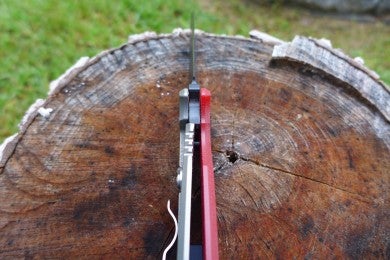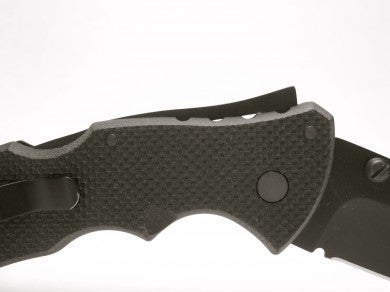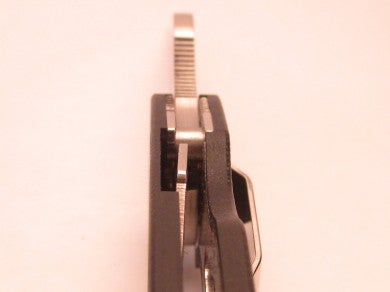How to Analyze Lock Strength in Folding Knives
Tony Sculimbrene 10.01.13

Reviewing gear is one thing, but scientifically and systematically testing gear is another. Very few people have the time, money, and knowledge to do this. One person that does is the always provocative Cliff Stamp. Cliff was kind enough to drop by my podcast on gear, Gear Geeks Live, for Episode 9. It was an enlightening discussion about all sorts of knife topics. One of my take-away lessons was that it is virtually impossible for customers to do systematic testing. This impossibility is most evident in our attempts to evaluate lock performance.
Science is about repeatable results over a large sample size. The random guy in his backyard busting up knives isn’t going to reach the thresholds for precision, duplication, and scale necessary to generate scientific and useful results. It’s possible, as Cliff pointed out, that the person got a lemon or a lotto ticket. The standards for production knives, even the nicest ones, varies significantly. My own personal experience with 154CM has proven this. So how do you gain any insight into a knife’s lock, especially with all of the marketing and hype out there right now? Here is how I look at folding knife locks.
A good folding knife lock has four important aspects; the lock must be strong, stable, easy to engage and disengage, and easy to clean and maintain. Figuring out just how well a lock does in all four categories is difficult, given our inability to perform systematic tests, but we have a workaround. There are forum boards filled with folks that own knives and use them extensively. If you have a consistent approach to looking at knife locks, then you can mine these sources for tons of information. Over time you may get a better picture than just looking at locks overall.
Breaking things down and casting a wide net for information may not yield scientific results, but it will give you higher quality information. One caveat with this approach is that you probably need to throw out the high and low evaluations. Fanboys will vouch that their lock is unbreakable, and crazy whiners will complain about snapping a blade cutting a graham cracker. Toss that stuff out and look in the middle.
Lock Strength
As Cliff pointed out in Episode 9, virtually all knives made today have locks that are sufficiently strong for most EDC tasks. The materials and designs for all but the cheapest stuff makes a knife lock on today’s knives plenty strong.
Going beyond this, you will notice a lot of companies testing the static load of a lock (how much weight a lock can hold without the weight or the knife moving). This is an interesting test, but it has little in the way of real world implications. Some companies will throw out huge numbers and have videos with tiny knives hold a whole set of weights, but those folks carefully and gently place the weight on the knife. How often are you carefully and gently using your knife to, for example, hang off the side of a building or step over a fence? Never. So, while interesting, the static load type tests don’t tell us much about real world use.
Similarly, a spine whack just seems like abuse. What does that simulate? What real world scenario is this supposed to imitate? By and large, all of these strength tests are the equivalent of supercar top speeds; they are theoretically useful but inapplicable in most real world cases. The bottom line is that virtually all modern knives have sufficiently strong locks for most reasonable uses.
Lock Stability
This is a place where knife locks do differ. It is also a place where information from the Internet can help. For example, some folks demonstrated that the ZT560 and ZT561 had serious problems with lock disengagement. Both Aaron at Practically Everyday and Cliff Stamp reported the same problem, and Aaron demonstrated that problem in a video (found here). The problem was that the lock did not engage and stabilize the tang of the knife. If it was pushed into place, the frame lock on the ZTs was plenty strong. This wasn’t a strength issue. The problem was the fact that without some purposeful movements, the lock bar didn’t snap into place.
This is a known issue with frame locks and liner locks, and it’s related to another problem: lock rock. The titanium used in most frame and liner lock knives is much softer than the steel of the blade, and over time the titanium can deform in a way that allows the knife to rock back and forth in the locked position. This rocking can get so severe that the knife “walks” out of the locked position and closes.
Another lock with a known issue is the button lock. Companies like William Henry, AG Russell, and Houge have all helped fix problems with the button lock, but in previous generations, as many sources on the Internet documented, the fit and finish on the button lock was not sufficiently tight to make it stay in place consistently. There was, again, a problem with stability.
By ignoring the issue of strength and focusing on lock stability, you get better more specific examples of problems. If you simply did research online about good locks, you might miss the issue of stability in a cloud of marketing hype surrounding lock strength.
Engagement/Disengagement
Many of the best knives in the world, titanium frame locks, have plenty of stability and strength, but they require a pry bar to disengage. That’s a problem. Titanium is known to be sticky even after it breaks in, and the locks that use titanium can exhibit this problem to varying degrees. It ranges from no biggie to deal breaker. Even high quality, well made knives have this issue.
The DPx HEST/F 2.0 is known to have an especially sticky lock. It pops into place easily when opening the knife, but even after three weeks of use, it occasionally stuck.
The other odd thing about sticky locks is that, more so than stability and strength, this can be an everyday issue. If you have to wrestle a knife closed, it probably won’t be your EDC for long. Equally problematic are locks that don’t engage well. Even the almighty Hinderer is known to have a flipper that doesn’t consistently deploy the knife and engage the lock. It needs a wrist flick to do that. Some think this is a “safety feature,” but it’s really a poorly made defect. We know this because, over different production runs, the Hinderer flipper has gotten more and more effective. It’s still not perfect, but it is improving. The Surefire Jekyll had a similar problem in the model I tested.
Cleaning and Maintenance
This is the lock bar of the Cold Steel Mini Recon 1. There are sorts of cuts and curves in the lock bar because of the design of a lock back and because of the extra considerations made necessary by the Tri-Ad lock. And here is the weird thing: for all of the abuse this lock can take, during my testing period it was foiled twice by pocket lint. There are so many crevasses in the knife’s lock that lint loves to hide in there, and twice it built up enough to prevent the lock from engaging. With the closed and housed setup on a lockback Tri-Ad design, this seems like a likely event.
Open pillar, liner based locks, like the wonderful Compression Lock seen below, do very well at keeping the lock area free of debris. They are also easier to access and maintain. I have tested two, and both worked exceedingly well.
Conclusion
Researching knife locks is like wading into shark infested waters wearing a cow carcass. There is so much marketing and hype that just looking at “locks” yields little information. Being more specific and tracking trends on the Internet from reliable sources and/or multiple sources can yield much better information. Breaking the analysis down like I did is very useful for me. It may help you, too.
Right now I really think the Compression Lock ranks the best on all four of my criteria, but this being the Golden Age of Gear, we have a bevy of very good choices. The Tri-Ad lock is great, the Compression lock is something I like, and I think the liner lock is criminally underrated.


